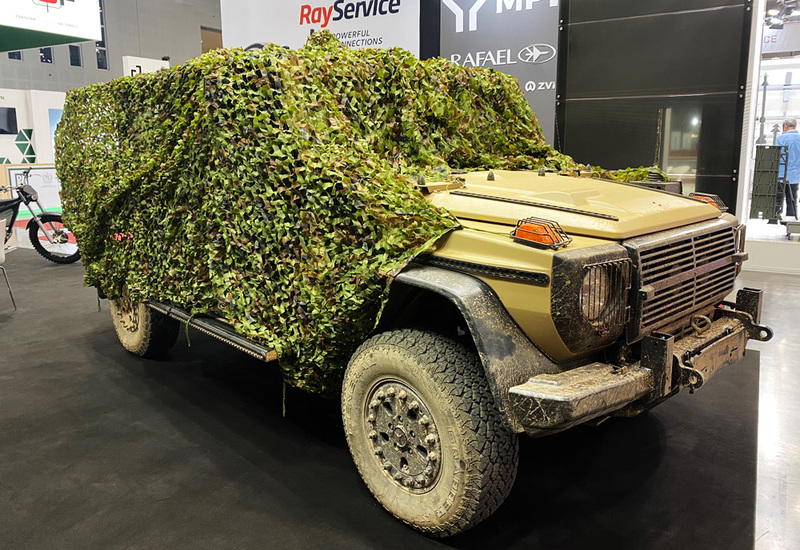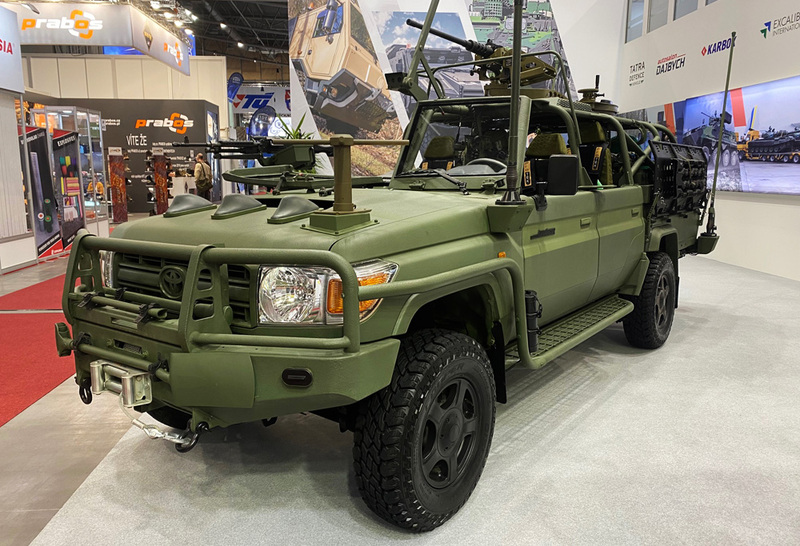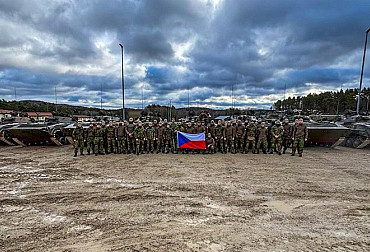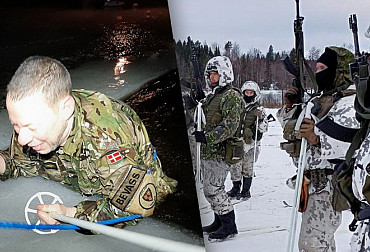Light Strike Vehicles: Modernisation of the Czech Airborne fleet
In October 2022, the Czech Ministry of Defence published the requirements for a new light strike vehicle to become the basic mobile platform of the 43rd Airborne Regiment. This is the next step in a process that has been underway for several years and is aimed at replacing the Land Rover Defender 130 Cayman vehicles, which are undeniably doing a good job, but are now in dire need of a successor. The army is asking for a total of 159 new vehicles in six variants and the specifications are formulated quite loosely, which may mean a significant number of different bidders. The market for airborne and special forces vehicles is a very lucrative sector, with many brands offering a variety of solutions to the military. Based on the published requirements and offers from suppliers, it is therefore possible to get at least a rough idea of the options available to the Czech military and which would appear to be suitable.
Let us recall that the Land Rover Defender 130 Cayman vehicles in use so far represent the third version of the legendary British off-road vehicle for the Czech Airborne and Special Forces. The earlier two were named SOV and SOV II, were also known as "Cowboy" and used the shorter Defender 110 as their base. Based on experience with their operation (including deployment in Afghanistan), the Cayman modification was born. 79 units were received by the 601st Special Forces Group and the 43rd Airborne Battalion, after which ten more units of a slightly different version, the Kajman M1, were acquired by the 102nd Reconnaissance Battalion. The Kajman vehicles, which were developed and produced by e.g. VOP 026 (now VOP CZ) and SVOS, were undoubtedly successful, but some weaknesses were also revealed. The vehicles operate de facto overloaded, as the additional ballistic protection consumes a large part of the load capacity, so this overloading logically has a negative impact on endurance and reliability. The Kajman's service life will end in 2025, not to mention that the original Defender platform ceased production in 2016, which of course means complications in maintenance and spare parts procurement for the Kajmans.
The Land Rover Defender platform is widely used in the Army, so a suitable replacement had to be found. The proven Japanese Toyota Hilux was chosen for the role of a light off-road vehicle for transporting people and cargo, but the question of a new platform for the Czech Army's special and airborne forces remains open and is accompanied by several cases. It should be recalled here that it was intended to purchase a trio of Supacat HMT 400 vehicles for the 601st Special Forces Group, but this acquisition did not materialise and instead the army relied on the domestic project Perun from the SVOS brand. Subsequently, however, a dispute arose between the army and the manufacturer over (non-)compliance, the ministry backed out of the contract and the case ended up in court. In addition, a project was launched to acquire a significantly higher number of vehicles for the 43rd Airborne Regiment, which needs to acquire all the new vehicles by 2026, when it is planned to reach full combat capability.
Picture: Five Enok 4.8 vehicles were purchased for the 601st Group | Martin Šiška / CZ DEFENCE
 Picture: Enok 4.8 on a Mercedes G chassis from the Bavarian company ACS at IDET 2021 | Jan Zilvar / CZ DEFENCE
Picture: Enok 4.8 on a Mercedes G chassis from the Bavarian company ACS at IDET 2021 | Jan Zilvar / CZ DEFENCE
Initially, there was talk of acquiring two platforms, a lighter unarmed one (weighing up to 3.5 tonnes) and a heavier armed one, but current requirements mean that only one will be purchased. The maximum weight is to be 9500 kg including ballistic protection at NATO STANAG 4569 Level 2, so the vehicles should be able to withstand 7.62×51 mm and 5.56×45 mm penetrating ammunition. They should carry a load of 2,000 kg and the basic version is expected to carry a complete squad (or 6 to 7 men) with weapons, equipment and supplies to operate independently for a minimum of 48 hours. The Army also requires, for example, a modular ballistic protection solution, armament integration, a maximum speed of 110 km/h and a range of 700 km. The vehicle's dimensions are to allow it to be transported in a CH-47 Chinook helicopter. In addition to the 75 LÚV-B basic combat vehicles, 27 LÚV-V command vehicles, 17 LÚV-S liaison vehicles, 18 LÚV-PTŘS vehicles carrying Spike LR anti-tank guided missiles, 13 LÚV-MIN vehicles equipped with Expal M-86 mortars and nine LÚV-Pz reconnaissance vehicles are also required. The contract also includes the delivery of 13 cargo trailers to be used to transport ammunition for the LÚV-MIN version.
As early as 2021, the Czech Army reported that up to 14 types of vehicles from 12 different suppliers could be considered, according to a marketing survey, although only a few manufacturers agreed to be explicitly named. Experts have, of course, also been able to list a number of other potential bidders whose names are likely to be included in that list. In principle, it can be said that there are two different principled approaches to the design of airborne and special forces vehicles. The former represents the construction of new platforms exclusively for military customers, whereas the latter relies on the use of existing designs that are also used in the civilian sphere. Perhaps the best known example of the first approach is the products of the aforementioned Supacat company, which are mainly used by special forces in Anglo-Saxon countries and were originally also favourites in the Czech Republic. Later, however, criticism was also levelled at the inadequate ballistic protection of persons in the open body, the inappropriate positioning of the engine in the middle (which does not provide protection against mines) or the defects of the braking system.
Another platform designed exclusively for airborne and special forces is the ATTV (Air Transportable Tactical Vehicle) from the Dutch company Defenture. It has been introduced, for example, into the arsenal of the local special forces under the name Vector and, for the sake of interest, it can be mentioned that it uses a chassis with a backbone frame that remotely resembles the solution of the Czech company Tatra. The contenders also include the respective variants of two contemporary army armoured vehicles, namely the Slovak Zetor Gerlach and the Nimr Ajban from the United Arab Emirates. The former was originally designed primarily for the Slovak Army's tender for an armoured vehicle of the MRAP category, but an open version of the Gerlach RDV for special forces was also introduced in 2021. The Ajban vehicle exists in a number of versions, including a version for special forces, the Ajban SOV Mk 2. It is worth mentioning here that its manufacturer has entered into a production licence agreement with the Czech company VOP CZ. Other vehicles from the USA are mentioned, namely the heavier Oshkosh JLTV, which is already in service or ordered by several NATO members, and the light Flyer 72 from General Dynamics and Flyer Defense, which is among others in the armament of the US Special Forces.
 Picture: Flyer 72 Heavy Duty Light Strike Vehicle | Michal Pivoňka / CZ DEFENCE
Picture: Flyer 72 Heavy Duty Light Strike Vehicle | Michal Pivoňka / CZ DEFENCE
The second approach, i.e. the use of existing utility vehicle platforms, is represented, for example, by the aforementioned Enok 4.8 type, essentially a special derivative of the Mercedes-Benz G-Class off-road vehicle. Another popular chassis platform is the Unimog, another product of the famous German carmaker, on the chassis of which the Venpir light armoured vehicle of the French brand Soframe or the LTTV of the British company Jankel are based. The list of contenders also includes the Eagle V, offered by General Dynamics European Land Systems. The first three generations of the Eagle, originally developed by Swiss firm MOWAG, were built on HMMWV chassis, while the fourth and fifth generation types use Swiss Duro series chassis. Candidates also include the SandCat armoured personnel carrier from the Israeli firm Plasan, which is based on the proven Ford F-series chassis. Several such vehicles were also used in the past by a special unit of the Czech military police.
Even more often, however, the Toyota Land Cruiser is used as a light strike vehicle for airborne and special forces. There are several brands in the world that have been successfully involved in such conversions, including the aforementioned British company Jankel or NSV Automotive from the United Arab Emirates. The Czech company Autosalon Dajbych is also active in the same field, and in cooperation with Tatra Defence Vehicle has designed a vehicle called Gepard. It now exists in two versions, the lighter RDV (Rapid Deployment Vehicle) and the heavier LRPV (Long-Range Patrol Vehicle), the latter of which was developed directly as a successor to the Kajman. In favour of the Land Cruiser platform are, for example, its exceptional durability, its wide distribution around the world (and the resulting possibility of using the Toyota service network) and, last but not least, the existence of six-wheeled variants with a higher payload (up to 3 tonnes), which can be optimally used, among other things, as platforms for some of the more powerful weapons systems.
 Picture: Long Range Patrol Vehicle (LRPV) – The Cheetah is based on the legendary Toyota Land Cruiser 70 series platform | Jan Zilvar / CZ DEFENCE
Picture: Long Range Patrol Vehicle (LRPV) – The Cheetah is based on the legendary Toyota Land Cruiser 70 series platform | Jan Zilvar / CZ DEFENCE
The Czech Army therefore faces a truly vast array of options, although it is likely that not all of the dozen or so applicants will be able to meet all of the specifications. In any case, the selection includes very light vehicles and types almost at the weight limit (such as the Supacat HMT 400), as well as vehicles designed from the outset exclusively for military roles (such as Supacat products again) and vehicles on existing platforms, including those from Mercedes-Benz and Toyota. Of course, the different approaches offer a variety of advantages and disadvantages in terms of, for example, protection against ballistic and explosive threats, suitability for air transport or service availability, so military experts will have to choose very carefully. Finally, it is worth emphasising that the selection should also take into account the involvement of Czech industry, or the possibility of the participation of domestic subcontractors or the assembly or even licensed production of new vehicles for Czech paratroopers.






















